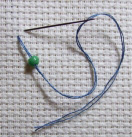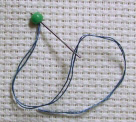- Home
- Attaching Beads
Attaching Beads To Fabric Securely
You can easily attach beads to your cross stitch project using a simple and secure method.
Seed beads can be used as a creative alternative to French knots in a design.
You can also use beads to create realistic jewelry in your embroidery, such as earrings or necklaces, adding a touch of elegance to your designs.
For example, I incorporated beads into my 1920s-inspired designs, Pearl and Coral, to create a pearl earring and necklace that add a sophisticated touch.
 Fig 1 - a beaded earring
Fig 1 - a beaded earringMaterials checklist
- Needles: beading/short sharps (sizes noted in decision chart).
- Thread: Nymo/KO, FireLine/WildFire, or silk (see chart).
- Beads: seed beads (15/0, 11/0), Delicas, or larger glass beads as required.
- Small sharp scissors
- thimble
- hoop/frame
- beading mat (or piece of corrugated cardboard with exposed ribs)
Fabric · Needle · Thread · Bead
| Fabric | Needle (typical) | Thread | Bead size & tip |
|---|---|---|---|
| Lightweight silk / organza / chiffon | Beading needle size 12–13 (very fine) | Fine silk or bonded nylon (KO) — gentle tension | Size 15/0 or 11/0 — test on scrap Tip: avoid heavy beads; use minimal pull. |
| Medium-weight linen / cotton | Beading needle size 10–12 | Nymo / KO or FireLine for extra strength | 11/0 / Delica — good uniform coverage Tip: use hooped tension for neat rows. |
| Knit / stretch fabrics | Big-eye needle or size 10 beading needle | Strong flexible thread (FireLine / WildFire) | 11/0–8/0; consider pre-stringing Tip: pre-stabilize fabric & use stretch-friendly stitches. |
| Heavy wool / denim / upholstery | Sharps size 8–10 or heavy beading needle | Heavy nylon / quilting thread or FireLine | Larger beads (8/0–6/0) — anchor well Tip: use reinforcement passes and backstitching. |
| Sheer / delicate embroidery fabrics | Extra-fine beading needle (size 13–14) | Fine silk or very fine nylon | 15/0 tiny seed beads Tip: test tension; use small anchoring stitches. |
How To Attach Beads Securely
Please note, to make the photography below easier to share with you, I have used a tapestry needle and a large bead.
1. To attach a bead with a cross stitch, bring the threaded needle up through the bottom left hole of the stitch, pass it through the bead, and then insert it into the top right hole of the stitch.
 Fig 2 - Step 1
Fig 2 - Step 12. Bring the needle up again in the bottom right as shown in Fig 3.
 Fig 3 - Step 2
Fig 3 - Step 23. Next, twist the bead slightly and push the needle through its center hole again. Finally, take the needle back down through the top right hole of the fabric.
 Fig 4 - Step 3
Fig 4 - Step 34. This will secure the bead firmly in place.
 Fig 5 - The bead is attached
Fig 5 - The bead is attachedDecorative Bead Techniques
You can easily adapt a cross stitch pattern to include beads, even if they're not part of the original design.
For example, adding seed beads to the centre of flowers or blossoms can add a beautiful touch.
Consider using beads to add details such as...
- eyes
- noses
- berries
- baubles on a Christmas tree
This simple addition can enhance your design and give it a unique personality.
Storing Your Seed Beads
For storing beads, consider using old photographic film containers or specialized storage containers. A simple trick is to tape a sample bead to the top of opaque containers for easy identification.
Alternatively, use small plastic bags with zip-lock closures, which come in various sizes and are available at craft stores or online. These transparent bags allow for easy viewing and secure storage, and can be labeled for quick identification, making them ideal for large bead collections.
 The top layer in my bead storage container
The top layer in my bead storage containerPractical Tips for Common Beading Issues
Working with beads can present challenges that impact your project's outcome. To overcome these issues, here are some practical tips to help you achieve beautiful beadwork.
1. Thread Breakages
Issue:
Threads can break if they're subjected to too much tension or if they come into contact with beads that have sharp edges.
Solution:
Use high-quality threads and prepare them properly to prevent breakage. To ensure your beading projects last, use strong threads like FireLine, Nymo, or silk threads with high tensile strength. This will help prevent breakage and keep your beads secure.
Additionally, take a few extra steps to prepare your threads and beads.
Wax your thread with beeswax or a thread conditioner to reduce friction, and inspect your beads for sharp edges. If you find any, discard them or smooth them out with a bead reamer to prevent damage to your thread.
2. Achieving Even Bead Placement
Issue:
Beads may not align uniformly, creating an irregular pattern.
Solution:
To ensure uniform bead alignment, it's essential to maintain consistent thread tension throughout the stitching process. This simple step can make a big difference in the overall appearance of your design.
For more intricate or symmetrical designs, consider using a ruler or template to guide bead placement. Alternatively, for freehand designs, lightly mark your fabric with a washable pencil or chalk to help you achieve a balanced pattern.
3. Dealing with Small Bead Holes
Issue:
Some beads, especially seed beads, have holes too small for standard needles.
Solution:
If you're having trouble threading beads with small holes, try using thin beading needles (sizes 10-15) specifically designed for this purpose.
If the thread still won't pass through, you can try a few additional tweaks: flatten the thread end with pliers, trim it at an angle, switch to a finer thread, or use a thread conditioner to reduce its thickness.
4. Preventing Beads From Rolling Away
Issue:
Beads can easily roll off your workspace while working.
Solution:
To avoid frustration and lost materials, use a beading mat or felt surface to keep beads in place while working. This simple solution will save you time and stress.
For added convenience, consider using a shallow tray or container to hold beads.
5. Running Out of Thread Midway
Issue:
Not having enough thread can cause breaks in the pattern and uneven stitching.
Solution:
To prevent this, always measure and cut more thread than you think you'll need.
If you do run out, tie a discreet knot close to the fabric and start with a new thread.
6. Preventing Tangles and Knots
Issue:
Long threads can become tangled or form unwanted knots during stitching.
Solution:
To avoid tangling or knotting your thread, use shorter lengths of no more than 18 inches. This simple step can significantly reduce the frustration of dealing with tangled threads.
If a knot does form, gently untangle it with a fine needle or pin. You can also run your thread through a thread conditioner to minimize friction and prevent future knots.
Mastering Beading Takes Practice And Patience
To improve, focus on developing steady hands and attention to detail.
As you practice, don't be afraid to try different tools and methods to find what works best for you. With time and experimentation, beading will become easier and more enjoyable.
Stay connected between projects
If you’d like occasional updates from my embroidery room, including new patterns, gentle tips, and little things I think you might enjoy, you’re warmly invited to join the Stitchin’ Times newsletter.
No pressure. Just a friendly note now and then to keep you inspired.



